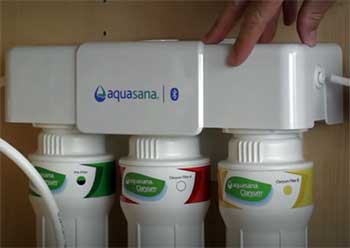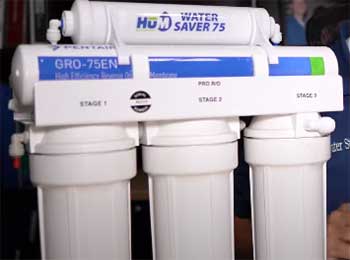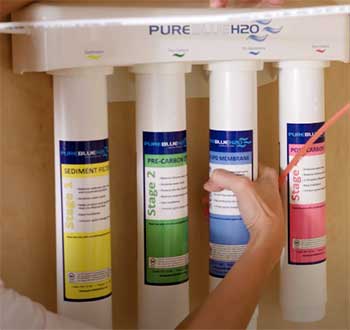When it comes to choosing the best water filtration system for your home, the debate between Aquasana and Reverse Osmosis (RO) is common.
Both promise cleaner, safer water, but they work very differently and suit different needs.
In this article, I’ll share my personal insights comparing Aquasana’s filtration technology and traditional RO systems.
By the end, you’ll have a clearer idea of which system fits your lifestyle, budget, and water quality expectations.
Comparison Table: Aquasana Vs. Reverse Osmosis
| Feature | Aquasana | Reverse Osmosis |
| Filtration Method | Activated carbon, ion exchange, sub-micron filtration | Semi-permeable membrane filtration |
| Removes Contaminants | Chlorine, chloramines, heavy metals, pesticides, VOCs, some bacteria | Removes nearly all dissolved solids, heavy metals, nitrates, fluoride, and microorganisms |
| Water Waste | Minimal to none | Produces significant wastewater (3-4 gallons per gallon filtered) |
| Water Taste | Improves taste by reducing chlorine and odors | Produces very pure, clean taste, but can be flat due to mineral removal |
| Installation Complexity | Moderate, mostly under-sink or whole-house options | Usually under-sink; more complex plumbing required |
| Maintenance Cost | Moderate, filter replacement every 6-12 months | Higher, membrane and filter replacement every 6-12 months |
| Mineral Retention | Retains beneficial minerals | Removes beneficial minerals, sometimes requires remineralization |
| Cost | Moderate to high depending on model | Moderate to high, with potential ongoing water cost |
| Water Flow Rate | Generally faster | Slower due to membrane filtration process |
| Environmental Impact | Low water waste | Higher water waste and energy use |
My Experience with Aquasana and Reverse Osmosis Systems

Having used both Aquasana and a Reverse Osmosis system at different points, I can share how they performed in my daily life.
Aquasana’s system stood out for its ease of use and the immediate improvement in tap water taste.
The water felt fresh without the “flat” taste often associated with RO water. Installation was straightforward, and maintenance was manageable with timely filter changes.
I especially liked how Aquasana’s filtration tackled chlorine and volatile organic compounds effectively, which is a big plus if your local water is treated with chloramines.
On the other hand, my experience with a Reverse Osmosis system was eye-opening in terms of purity.
The water was incredibly clean, removing almost every detectable contaminant, including fluoride and nitrates that some systems can miss.
However, I noticed the water lacked minerals, which gave it a somewhat bland taste until I added a remineralization filter.
The biggest downside was the amount of water wasted during filtration—an environmental concern and a practical annoyance, especially when water bills are high.
The RO system also required more plumbing work during installation and slightly more frequent maintenance due to the membrane’s sensitivity.
Despite these drawbacks, if you have serious water quality issues or need ultra-pure water for health reasons, RO can be a strong contender.
Understanding the Environmental Impact of Aquasana and Reverse Osmosis Systems
When deciding between Aquasana and Reverse Osmosis, one important factor that often gets overlooked is their environmental impact.
Having used both, I realized just how differently they affect water consumption and waste, which can influence your decision if you’re eco-conscious.
Aquasana systems stand out because they produce minimal to no wastewater during filtration.
This means almost all the water that enters the system comes out as clean, drinkable water.
For me, this was a big selling point because it aligns with my goal of reducing water waste at home.
Plus, since Aquasana retains beneficial minerals, it doesn’t require additional processes to restore water quality, which saves energy.
On the other hand, Reverse Osmosis systems generate a significant amount of wastewater—usually about three to four gallons of water are wasted for every gallon filtered.
This struck me as quite inefficient, especially in areas where water conservation is crucial. Over time, that waste adds up and can increase your water bill substantially.
The energy consumption involved in RO systems, particularly if paired with pumps or additional filters, also contributes to a larger environmental footprint.
If you’re someone like me who values sustainability, Aquasana’s eco-friendly profile might tip the scales in its favor.
However, if water purity is your top priority and you’re willing to accept the environmental cost, RO systems provide unmatched filtration.
Ultimately, balancing your health needs with environmental concerns is key to making the right choice.
How Installation and Space Requirements Affect Your Choice
One aspect I didn’t consider at first was how installation complexity and space requirements would impact my day-to-day experience with these filtration systems.
Aquasana systems generally offer more flexible installation options. Whether you want a whole-house filtration system or a simple under-sink unit, Aquasana has models that fit various spaces and skill levels.
Installing their under-sink models was straightforward for me and required only basic plumbing skills.
The compact design fit nicely without crowding my cabinet space, and the minimal maintenance means less hassle overall.
Reverse Osmosis systems, however, tend to be more complicated. The need for multiple filter stages, the RO membrane, storage tank, and sometimes a dedicated faucet, means they take up more space under your sink.
For me, it felt a bit cramped and required careful planning to avoid clutter. Additionally, installation often demands professional help or at least a decent understanding of plumbing, which can add to upfront costs and delay usage.
If your kitchen or utility area is limited in space, Aquasana’s smaller footprint and simpler setup might be the better option.
But if you have the room and are comfortable with a more involved installation, RO’s superior filtration could justify the extra effort.
Choosing the right system includes practical factors like these—ease of setup and space—that will impact your satisfaction day-to-day.
Pros and Cons of Aquasana and Reverse Osmosis

Aquasana Pros:
- Removes chlorine, chloramines, lead, mercury, pesticides, and VOCs effectively
- Retains beneficial minerals improving water taste and health benefits
- Minimal water waste during filtration, environmentally friendly
- Easy installation and user-friendly maintenance
- Provides whole-house and under-sink options to suit different needs
- Filters last longer, reducing frequency of replacements
Aquasana Cons:
- Does not remove dissolved solids like fluoride, nitrates, and some heavy metals as thoroughly as RO
- Not ideal for homes with extremely poor water quality or contaminants requiring membrane filtration
- Higher upfront cost compared to some basic filters
- Filter replacement can be expensive over time
- Limited removal of microbial contaminants compared to RO
- Some users report slight reduction in water pressure
Reverse Osmosis Pros:

- Removes up to 99% of dissolved solids, heavy metals, fluoride, and microorganisms
- Produces very pure and safe drinking water
- Effective for people with compromised immune systems or specific health concerns
- Widely tested and trusted technology for water purification
- Can be combined with remineralization filters to improve taste
Reverse Osmosis Cons:
- Wastes significant amounts of water (3-4 gallons per gallon purified)
- Removes beneficial minerals leading to flat taste without remineralization
- Installation is more complex and may require professional help
- Membrane and filters require frequent replacement, increasing maintenance costs
- Slower filtration process leading to lower water flow rates
- Environmental impact due to water waste and energy consumption
Maintenance Tips for Aquasana and Reverse Osmosis Systems
Aquasana Maintenance Tips:
- Replace filters according to manufacturer’s schedule (usually every 6 to 12 months) to maintain optimal performance
- Clean pre-filters regularly if your system includes them to prevent clogging
- Check for leaks or worn parts during routine inspections
- Flush the system occasionally to remove trapped contaminants and ensure water freshness
- Use only genuine replacement filters to maintain system warranty and effectiveness
- Monitor water pressure; reduced flow may indicate filter replacement is needed
Reverse Osmosis Maintenance Tips:

- Change the RO membrane every 2 to 3 years, or sooner if water quality declines
- Replace sediment and carbon pre-filters every 6 to 12 months to protect the membrane
- Sanitize the system annually to prevent bacterial growth
- Check and replace post-filters, including remineralization filters, regularly
- Monitor water pressure and reject water volume to detect system issues
- Use a professional for installation and complex maintenance tasks to ensure system longevity
Also Read: Comparison Of Aquasure Vs. SpringWell Water Softener
Aquasana Vs. Reverse Osmosis: Which Should You Choose?
Choosing between Aquasana and Reverse Osmosis depends largely on your water quality needs, budget, and environmental concerns.
If you want an eco-friendly option that improves taste, retains minerals, and is easier to maintain, Aquasana is a solid choice.
Its technology suits households where chlorine, chloramines, and common chemical contaminants are the main issues.
On the other hand, if your water source has high levels of dissolved solids, fluoride, or you require ultra-pure water, Reverse Osmosis is more effective.
Keep in mind the higher water waste and maintenance needs of RO systems.
Also consider your lifestyle—Aquasana’s faster water flow and simpler installation might be better for busy homes.
At the end of the day, both systems have their strengths and trade-offs.
Assessing your water test results and priorities will guide you to the best decision for your health and home.
Also Read: Comparison Of Rheem Vs. A.O. Smith Water Softener
Frequently Asked Questions (FAQs)
Aquasana has faced lawsuits related to false advertising claims about their filtration capabilities, specifically concerning removal of certain contaminants. It’s advisable to review the latest information before purchasing.
Some advanced filtration technologies, like ultrafiltration combined with activated carbon and UV treatment, offer alternatives but RO remains one of the most thorough at removing dissolved solids.
Drinking RO water regularly might lead to mineral deficiencies since the process removes beneficial minerals. Many users prefer remineralized RO water or combine RO with mineral filters.
Yes, Aquasana offers effective filtration for chlorine, heavy metals, and other contaminants while retaining beneficial minerals. It’s suitable for many households but may not address all contaminants like RO.
Final Thoughts
Choosing between Aquasana and Reverse Osmosis means weighing your water quality needs, maintenance willingness, and environmental impact.
I’ve found Aquasana to be convenient and eco-friendly, perfect for typical city water concerns.
Reverse Osmosis offers unmatched purity but at the cost of water waste and more upkeep.
Understanding these differences helps you make an informed choice that fits your home and lifestyle. Whatever you pick, cleaner water means better health and peace of mind.
